Help
SearchCulture,gr provides access to and unified search of digital items of reputable cultural institutions. This content is constantly enriched with new material. At the same time, SearchCulture.gr offers a dynamic experience of exploring the digital cultural content it aggregates. Users of the portal can navigate digital cultural content through the following pages:
In addition, users of SearchCulture.gr can discover documents by using the content search form. Search results appear paginated with 30 items per page. For each item, users can choose to view details in item tabs on a separate page by clicking on the title or the corresponding preview image. Below are detailed instructions on the navigation and content search capabilities provided by SearchCulture.gr.
Most of the functionalities described in this guide have been implemented thanks to the extensive semantic curation carried out by EKT's scientific staff on the original documentation of the collections collected in the SearchCulture.gr.
Most aggregators face problems with findability, multilingual searchability and presentation of the content they host due to the heterogeneity of the metadata they gather. SearchCulture.gr is considered a model infrastructure for European standards, especially thanks to the systematic semantic enrichments carried out by EKT's scientific staff in all material on subjects, content types, persons, dates, historical periods, and places. For the implementation of these enrichments, vocabularies were developed in Semantics.gr infrastructure, a platform for publishing semantic resources as Linked Open Data developed by EKT. Semantics.gr also includes a mapping tool to carry out semantic enrichments.
Semantic enrichments improve the quality and validity of data, add a level of multilingualism, allow the development of advanced search and navigation capabilities in content and serve the semantic linking of items belonging to different collections. Most of the functionalities described in this guide have been implemented thanks to the following semantic enrichments.
The enrichment process does not affect the original documentation, and the values resulting from the process are marked distinctively on the SearchCulture.gr portal. Original values are searchable (indexed like all other fields) and still appear on the item view page.
Users can explore content through the home page of SearchCulture.gr. The homepage includes:

Using the interactive timeline on the SearchCulture.gr homepage, those interested can search for items related to modern Greece and explore specific time periods.

Through the Browse menu, users can browse through types, subjects, persons, places and historical periods as well as through an interactive map. They can also browse through the institution pages and collections pages as well as through the thematic exhibitions curated by EKT.
SearchCulture.gr has a dedicated page to browse the content of all EKT Persons. The page can be accessed from the options menu by selecting "Browse→ Persons".
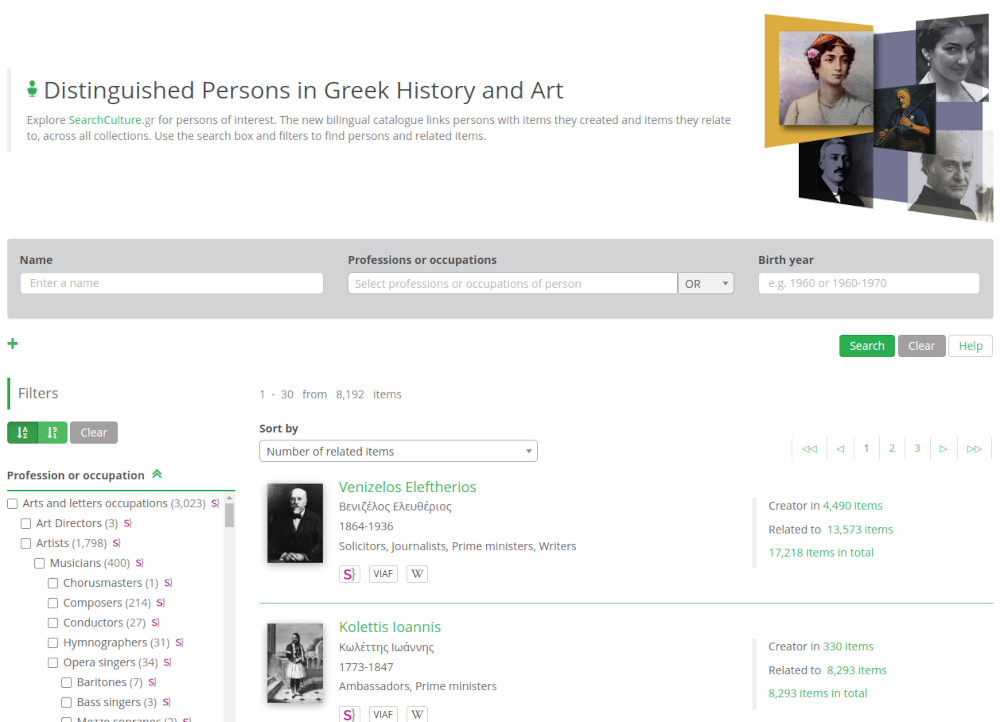
This page is suitable for searching persons by name, professions/occupations or date of birth. Users can choose from a list of professions/occupations. At the same time, it is possible to sort them in various ways, i.e. sort by date of birth, descending or ascending, or by the number of items relating to a person as an author or as a referenced person, the number of items in total or the names of persons in alphabetical order. The profession/occupation and date of birth also act as filters for results.
Each person record includes a photo or portrait of the person, key biographical information that identifies him/her (the dates of birth and death), the main profession or occupation of the person, as well as links to the relevant articles on Wikipedia and the Virtual International Authority Files (VIAF) etc. There is also a link to the record of the person in the vocabulary "Persons in Greek History and Art" on Semantics.gr.
Links to related items on SearchCulture.gr are given for each person. Users can choose to view items of which the person is the creator, items referencing the person or all the items relating to the person.
Clicking on the name of each person takes users to the relevant page.
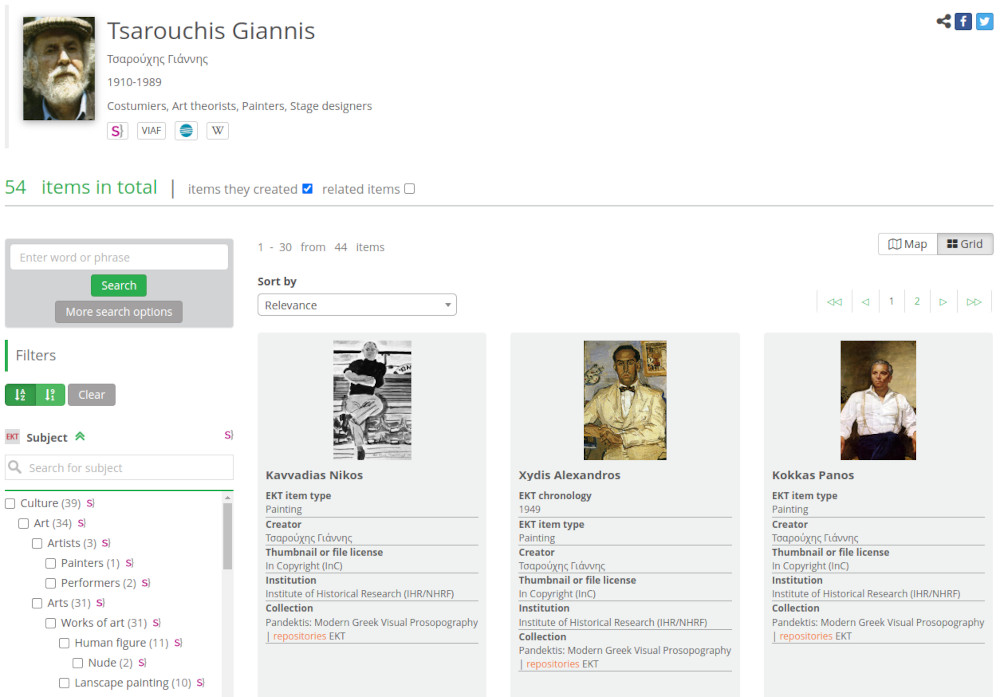
Where available, there is a portrait or photo of the person alongside key information and links to relevant records shown on the Persons page. Results can be filtered: either items of which the person is the creator of or items that reference the person. Results can be viewed either on a grid or on a map (The function of the map is described in detail in the section "Using the Map page"). On the left are the facets (The facets function is described in detail in the section "Search results").
SearchCulture.gr has a dedicated page with all the EKT Types into which the items were classified during the enrichment process. The page can be accessed from the options menu by selecting "Browse→ Item Types".
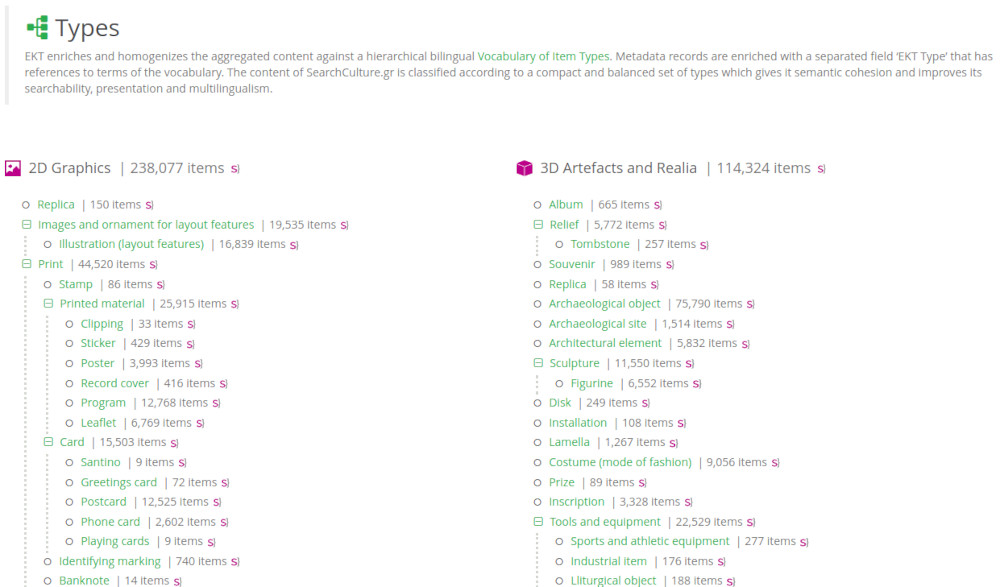
The Types appear hierarchically grouped into 8 categories: "2D
Graphics", "3D artifacts and realia", "Text", "Sound Recordings",
"Projected and Video Material", "Scores", "Cartographic Material",
"Cultural production", "3D representations" and "Intangible Cultural
Heritage". Each type links to the results page with the
corresponding items. Each type is accompanied by the number of items
and a link " "" which leads to the page
of the corresponding term in EKT’s Item Types Vocabulary in Semantics.gr.
"" which leads to the page
of the corresponding term in EKT’s Item Types Vocabulary in Semantics.gr.
SearchCulture.gr has a dedicated navigation page across all the subjects into which the items were classified. The page can be accessed from the options menu by selecting "Browse→ Subjects". Here, users can explore the content of SearchCulture.gr using the hierarchical classification of subjects as classified by EKT.
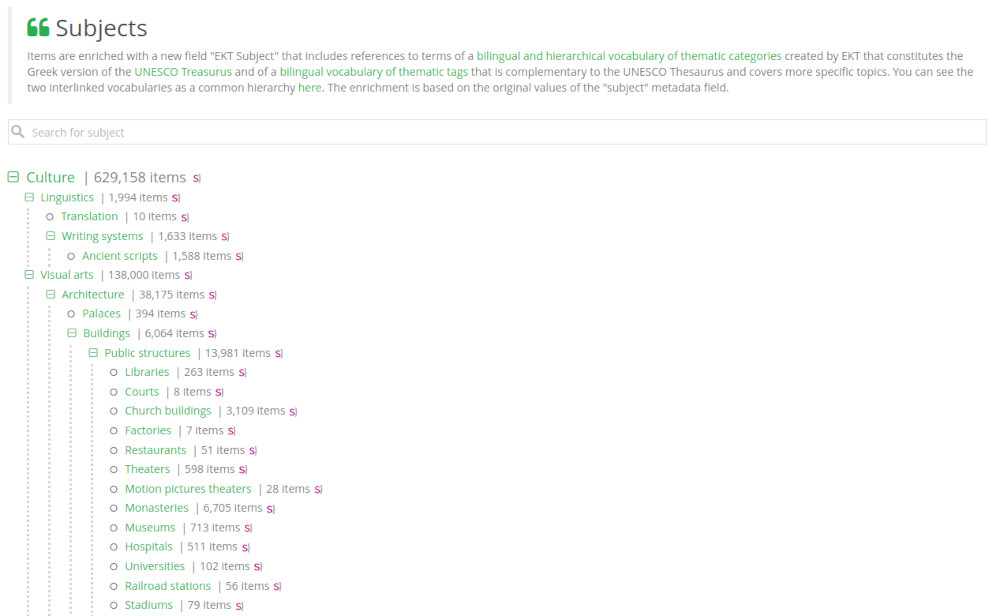
Users can also browse content through the Historical periods into which the items have been classified. This page can be accessed from the options menu by selecting "Browse→ Historical periods".
Historical periods appear hierarchically. Each period is linked to
the results page with the corresponding items and is accompanied by
the number of items and a link " ", which leads to the
corresponding term of EKT's Greek Historical Periods vocabulary τin
Semantics.gr.
", which leads to the
corresponding term of EKT's Greek Historical Periods vocabulary τin
Semantics.gr.
For the Bronze Age (3200 – 1050 BC), the user can choose to view the individual historical periods of the three civilizations that flourished in parallel in Greece: the Cycladic, the Mycenaean and the Minoan.
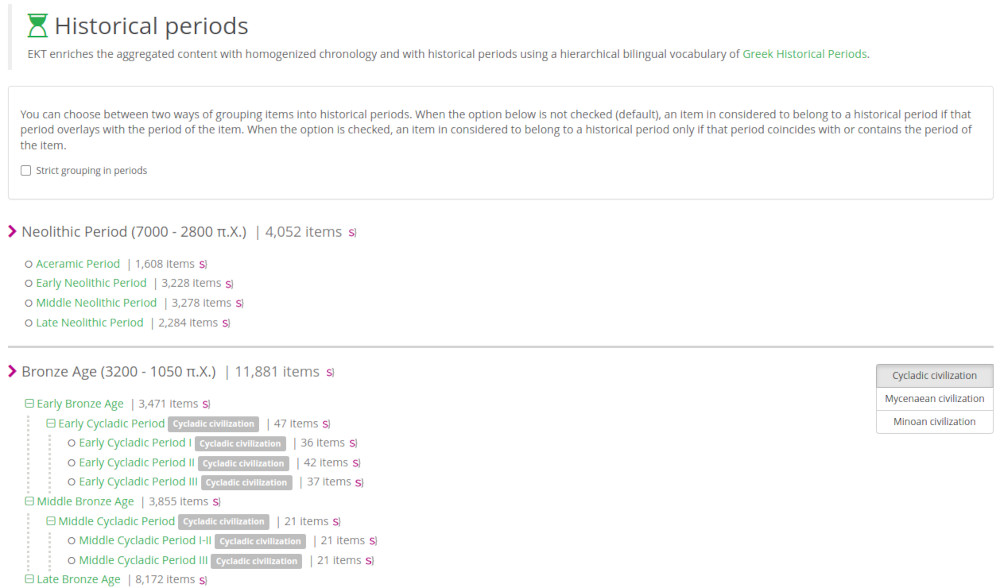
Going to the Historical periods page, users can choose between two ways of grouping items into historical periods, ‘broadest and ‘strictest’.
Choosing ‘broadest’, items are pinpointed when that time period simply overlaps with the historical period or range of historical periods to which the item is dated.
Users can, however, choose the ‘stricter’ mode. Through this option, an item is traced to a historical period only if that period is either identical to or fully includes the historical period or range of historical periods to which the item belongs.
SearchCulture.gr has a dedicated page to browse content across all EKT Places. The page can be accessed from the options menu by selecting "Browse→ Places".
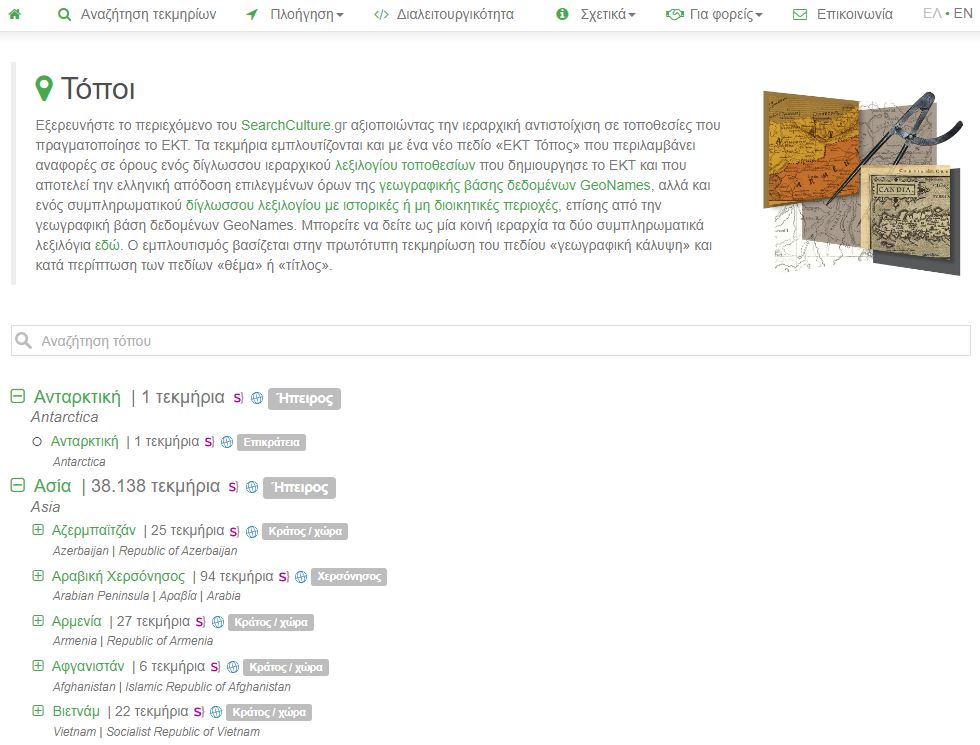
Places are shown hierarchically. The list includes terms belonging to two hierarchical vocabularies created by EKT, a basic vocabulary that is the Greek version of selected terms from the geographical database GeoNames, and a supplementary bilingual vocabulary with historical or non-administrative areas, also from the geographical database GeoNames. The two complementary vocabularies appear on the navigation page in a single hierarchy.
Users can easily search the terms. The term input field has an auxiliary mechanism for auto-filling values: as the user types the first 3 letters, the list of possible values appears.
Each place links to a results page with the corresponding items. At
the same time, it is marked with a label that classifies it (e.g.
State/Country, River, Archaeological site, etc.). Each place is
accompanied by the number of items to which it is related,
alternative names, a link " " which leads to the page
of the corresponding term of EKT's Places Vocabularies in
Semantics.gr and finally by the link "
" which leads to the page
of the corresponding term of EKT's Places Vocabularies in
Semantics.gr and finally by the link " " that leads to the
page of the corresponding term of the geographical database
Geonames.
" that leads to the
page of the corresponding term of the geographical database
Geonames.
SearchCulture.gr enables users to search on a map. This page is accessible from the menu, selecting "Browse→ Map".
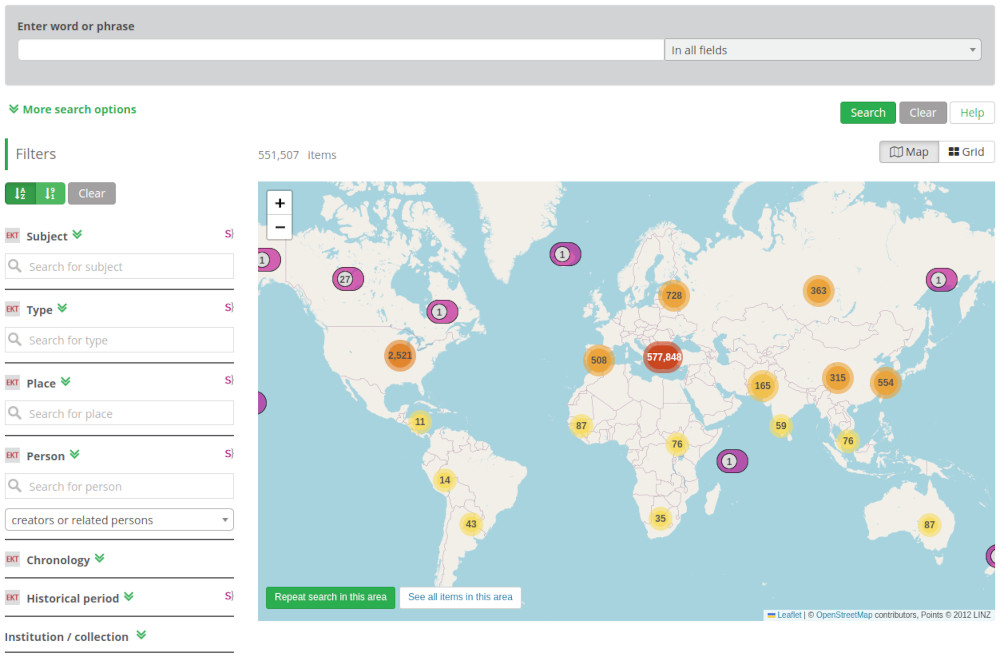
The map shows all the items that have been enriched in geographical terms from the two hierarchical vocabularies developed by EKT. Users can search the interactive map clicking on places that interest them. Orange and yellow are "clusters" that can be expanded, while purple shows specific results per location. Users can click on the purple markers to see a preview of 2 of the items associated with this place, while clicking on the "See all items" option in the pop-up box shows all items that have been enriched with this geographical term.
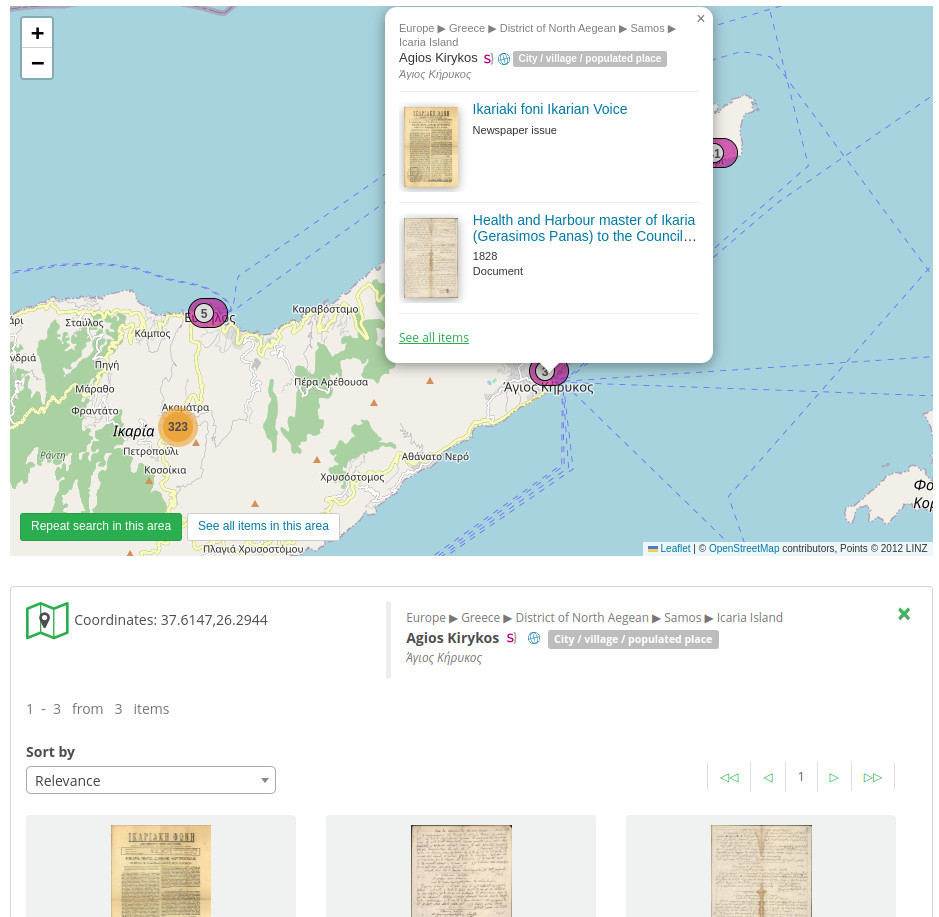
Clicking on the option "View all items on the map", users can retrieve all the items located in the map window, within the coordinates of the specific frame.
On the left are the facets. The function of filters is described in detail in the section Search results.
By pressing ‘Repeat search in this area’, the facets automatically show the items appearing in the coordinates of the specific map frame.
In some cases, retrieving all the results of a cluster of items on a site gives the additional ability of sharing the results. By clicking on a specific location i.e.‘Kea’ [Nissos Kea] users can choose between two categories of items. The first is items that in their documentation explicitly give the geographical designation of ‘Kea’ [Nissos Kea] or ‘Tzia’ etc. and the second, items located in places that fall hierarchically under the broader term (in our example, items located in specific towns on the island).
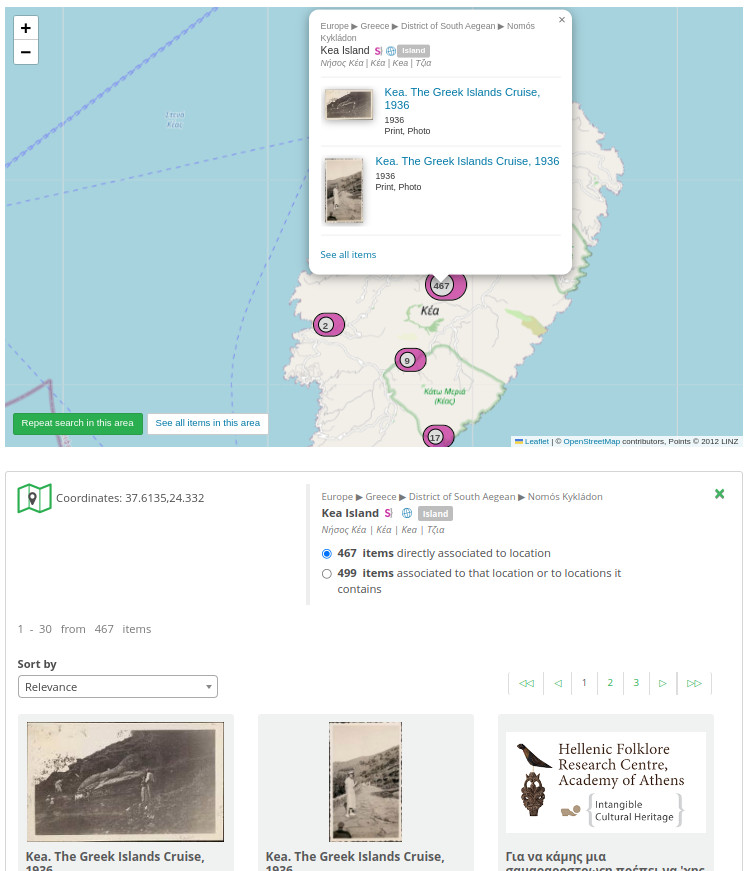
In some cases, two place names appear in the same place on the map due to the coordinates given to them by the geographical base Geonames. In the example of the image below we see that the clusters of geographical terms ‘Asia Minor’ and ‘Turkey’ are placed at the same point on the map as both have the coordinates 39.35 in the respective terms of Geonames. By selecting to view all the items, the user can see 1,626 items that in their original documentation had the term Asia Minor, or 16,331 items that in their original documentation had either Asia Minor or place names that hierarchically fall under it (eg Pontus, Smyrna, Troad, etc.). Likewise, there is the same possibility for items that are either located in Turkey in general or belong to areas administratively falling under the term Turkey (eg Eastern Thrace, Constantinople, River Saggarios, etc.).
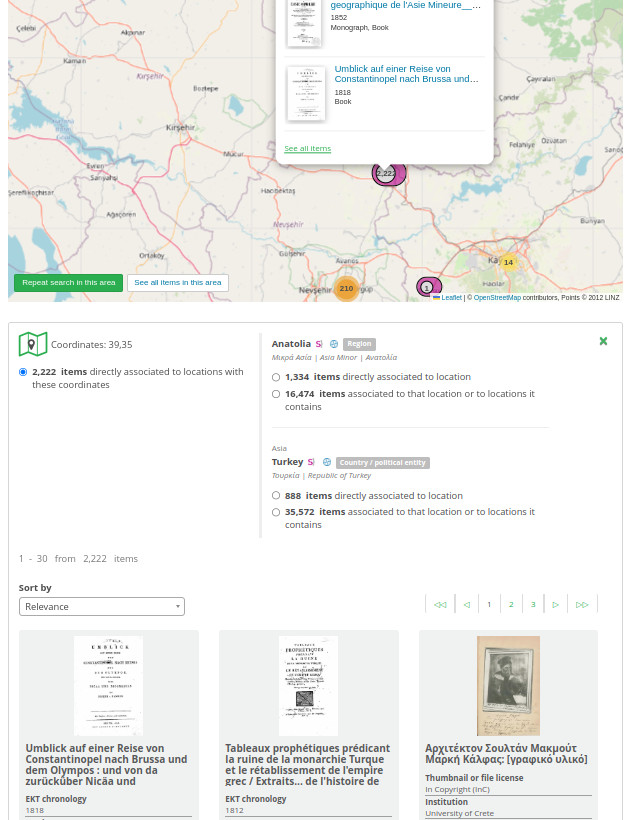
SearchCulture.gr also devotes a page to each institution contributng data to the aggregator. These pages can be accessed from the menu, by selecting "Browse → Institutions".
Institutions are shown in alphabetical order. On the Institutions page, users can search and select a specific type of institution from a drop-down menu.
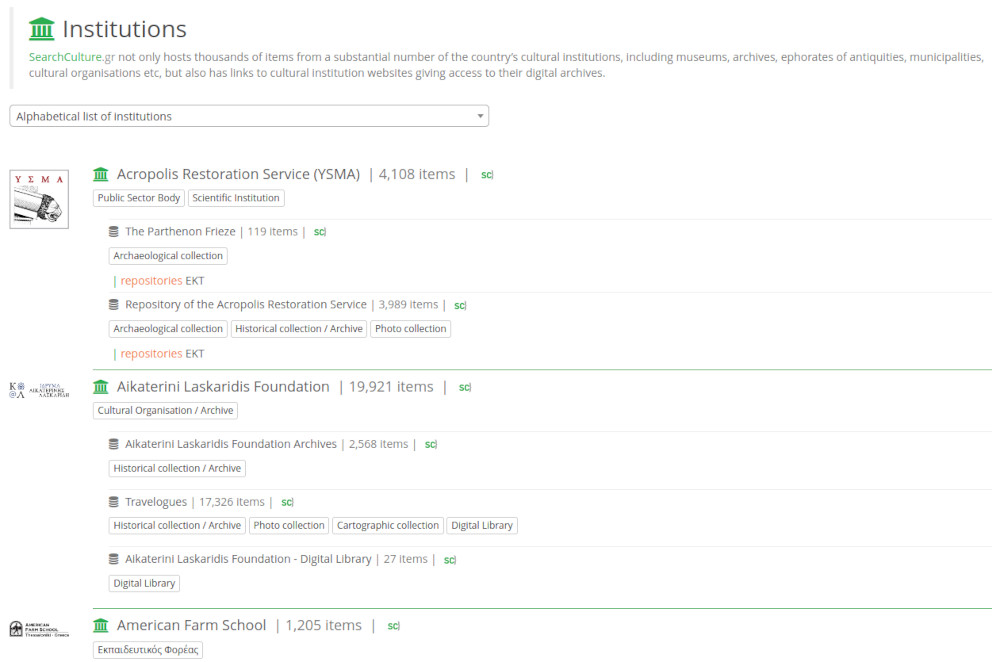
Under each institution one can find its category (e.g. Educational institution, Scientific society, etc.) and its collections are listed below it. By selecting the title of the desired institution, the user is taken to its tab. There one can find information about the institution and its collections, references to the website of both the institution and the repository/collection, descriptions and logos.
On the ‘Collections’ page, which is accessible from the menu, by selecting "Browse → Collections", users can browse through all the collections hosted in the aggregator and discover the type of collection (e.g. Institutional Repository of Universities/Technological Educational Institutes, Museum, etc.) and the number of its items.
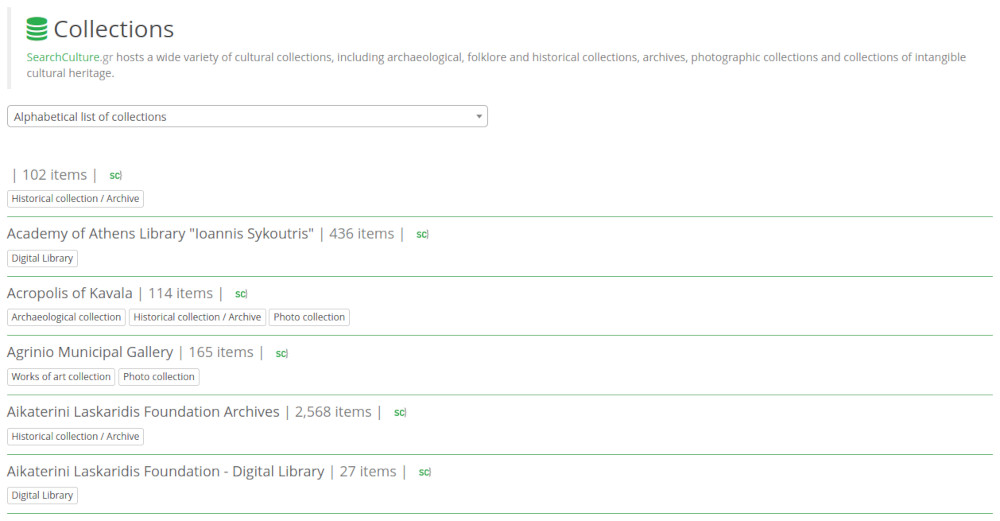
Users can navigate through the items of each collection in the collection page.
SearchCulture.gr also gives the option to browse the Thematic Exhibitions. The Exhibitions page can be accessed from the menu by selecting "Browse→ Thematic exhibitions".
Thematic exhibitions are curated virtual exhibitions comprising of sets of items telling a story. Dozens of thematic exhibitions are available in SearchCulture.gr, which include, among other things, art and photography exhibitions about a certain time period, various exhibitions about the Byzantine culture, crafts and folklore exhibitions and others highlighting diverse times in Greek history and culture. The thematic exhibitions demonstrate the breadth and variety of historical, artistic, social and political topics that users can discover through SearchCulture.gr.
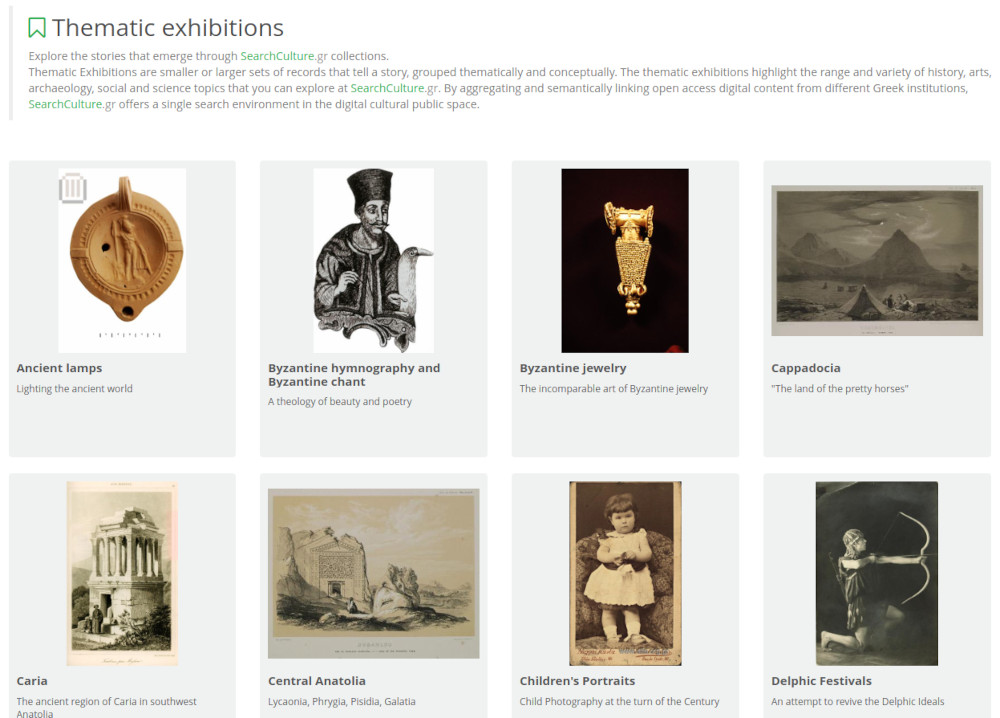
Each exhibition includes a title, an indicative image, a descriptive text offering some contextual background and the selected items. Depending on the nature of the collection, the curator preselects the presentation of the results either on a map or on a grid. Users can change this option by pressing the corresponding button. On the left are the facets for filtering results.
The function of facets is described in detail in the section "Search results". he function of the map is described in detail in the section "Browse the map page"
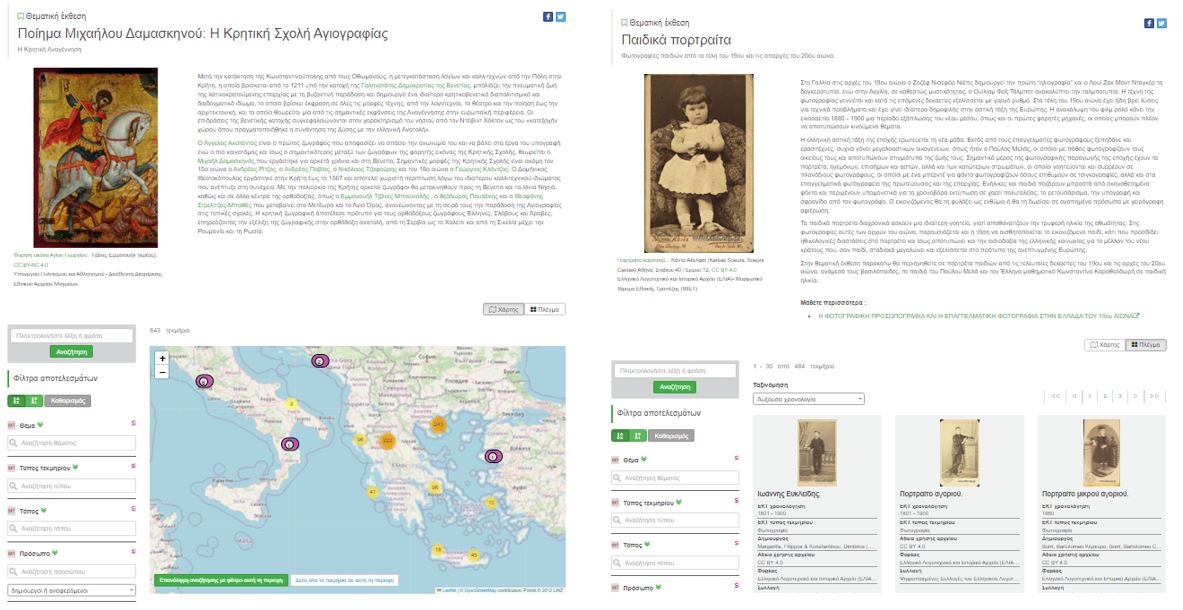
The search form appears on both the home page and the search page (see "Search Items").
Users can enter a term (word or phrase) and, if desired, choose to search only under that heading or in all fields. The term input field has an auxiliary mechanism for auto-filling values: as the user types, a list of possible values is displayed.

Clicking on More search criteria, the box wraps and the user can search more fields.
In the fields Item Type, Subject, Person, Person occupation and Place the user can add multiple types and with the option AND/OR retrieve items that have all the selected terms or at least one of them. When the term belongs to one of EKT's vocabularies, the user can see the corresponding page on the semantics.gr by clicking on the symbol. The menu has an autofill mechanism.

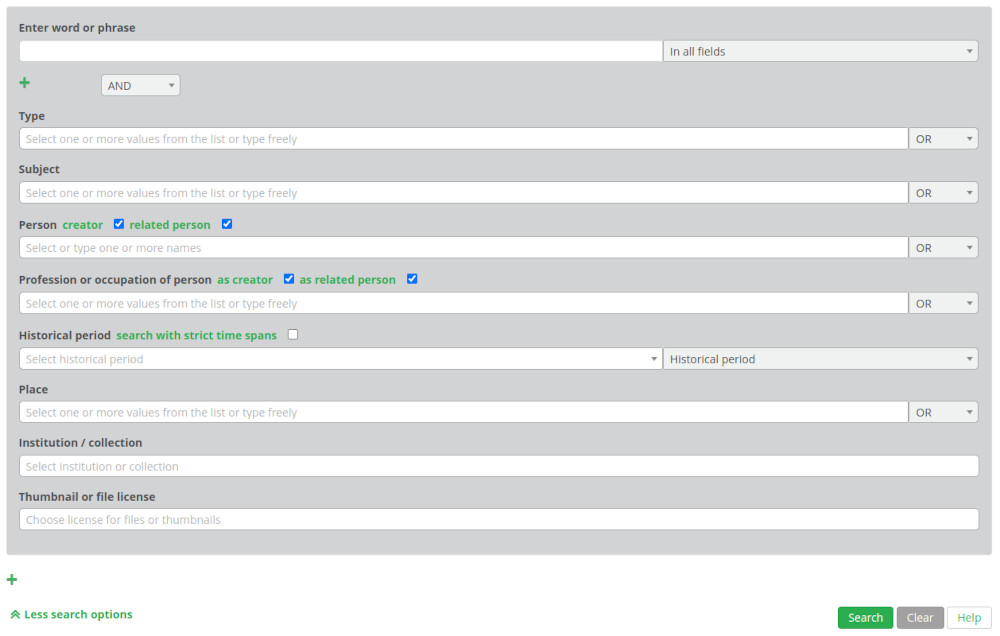
In the fields Item Type, Subject, Person, Person occupation and Place the user can add multiple types and with the option AND/OR retrieve items that have all the selected terms or at least one of them. When the term belongs to one of EKT's vocabularies, the user can see the corresponding page on the semantics.gr by clicking on the symbol. The menu has an autofill mechanism.
The search form enables us ers to select one or more EKT Item Types through a selection menu which presents EKT types hierarchically.

If, however, the item type does not exist in EKT's Cultural Content Types vocabulary, the user can type a different term.
The user can search for items based on the subject of the item. Starting to type a term presents the terms of the vocabularies used for the semantic enrichments carried out by EKT in the aggregated content. The user can add multiple terms and subjects that do not exist in the vocabularies of EKT.
In the Person field, the user searches for creators or referenced person or both (by clicking on the options ‘as creator’ and ‘as reference’). Starting to type a term, the persons from the vocabulary of established terms "Persons of Greek History and Art" are presented. Each established person term includes a photograph or portrait, main biographical information and profession as well as a link to the corresponding page of the term in the Semantics.gr.

Another search criterion related to the individuals on SearchCulture.gr is Person Profession/Occupation. The user can search for items that have been created or in which specific professions are mentioned (e.g. Politicians, Actors, Artists etc.) Starting to type a term presents hierarchical terms from the vocabulary of Professions/Occupations. The field is multiple, but one can choose terms exclusively from the vocabulary. Each term has a corresponding redirect button to the corresponding page of the term on Semantics.gr.

The user can search for items based on chronology with two different types of temporal criteria, either by selecting a Historical period of the corresponding EKT vocabulary or by entering a chronological period l(e.g. ‘1500 - 1600 AD’).

Regardless of the time criteria, the user also has the option of choosing between two time search modes, the "broadest" and the "strictest" , by clicking on the search option within strict time limits.
Similarly, in a search using a historical period i.e. "Classical Period", an item with the time coverage "Classical to Hellenistic Period" will appear in the results list.
When strict time limit search is selected, temporal search is rigorous and only items with a chronological interval or historical period that either match or are fully included in the chronological period or period of the search are displayed. This option is only used to find items that date strictly within specific intervals or periods. For example, in the search with a chronological interval of "1500 - 1600 AD", the item dated "1550 - 1750 AD" will not appear in the results, while an item dated "1550 - 1570 AD" will appear. Similarly, in the search for a historical period, say, "Classical Period", an item with a time coverage of "Early Classical" will appear in the results list, while an item in the historical period "Classical to Hellenistic Period" will not appear. The form allows the user to search for content in multiple institutions or collections/repositories
Finally, the user can select one or more digital content licences from a list.
It is possible to use multiple search forms. By pressing + below the form, the user can add another advanced search form that complements the first, selecting ‘AND’, ‘OR’, or ‘NO’.
This allows the user to make even more specialised searches.
Search and navigation results are displayed in two ways. In a grid (default) or on a map. The user can choose either by selecting the corresponding option.

In the "grid" option, the results are paginated with 30 items per page. A preview image and selected field values are displayed for each item. It is also possible to sort search results into chronological order (ascending or descending). It should be noted that undated items are excluded from this view.

In addition to the basic metadata and a preview image, it is also
possible to view the RDF representation of the item's metadata (RDF
button), a quick view of the items (( ) ) and copying of
the URI of the item (
) ) and copying of
the URI of the item ( ).
).
The item search allows the filtering of the results with a facet mechanism in specific fields including Subject, Type of item, Place, Person, Dating (at intervals of 50 years), Historical period, collection/repository, Europeana type, file licences and language.
Search filters have buttons with which the user can choose whether filter values appear in their natural order (alphabetical or chronological) or in descending order based on popularity.
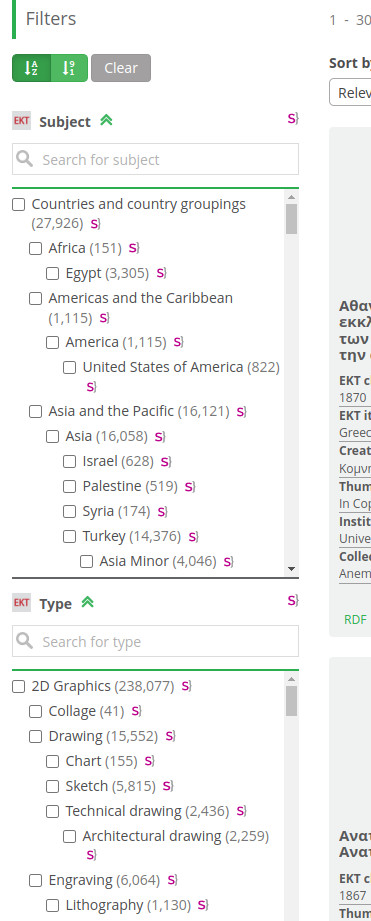
The values of the Subject, Type, Place, Historical period, and Institution/Collection filters are displayed hierarchically. In the Subject, Type, Place, and Person filters, the search field has an auto-complete mechanism to help fill in the search field while typing.
By clicking on the option to display the results on a Map, the user is taken to an environment identical to the one already described in the section Browse the Map page. Please note that only items that have geographical information appear on the map.
For each result, users can view the details of an item, on a separate item page, by clicking on the title or preview image.
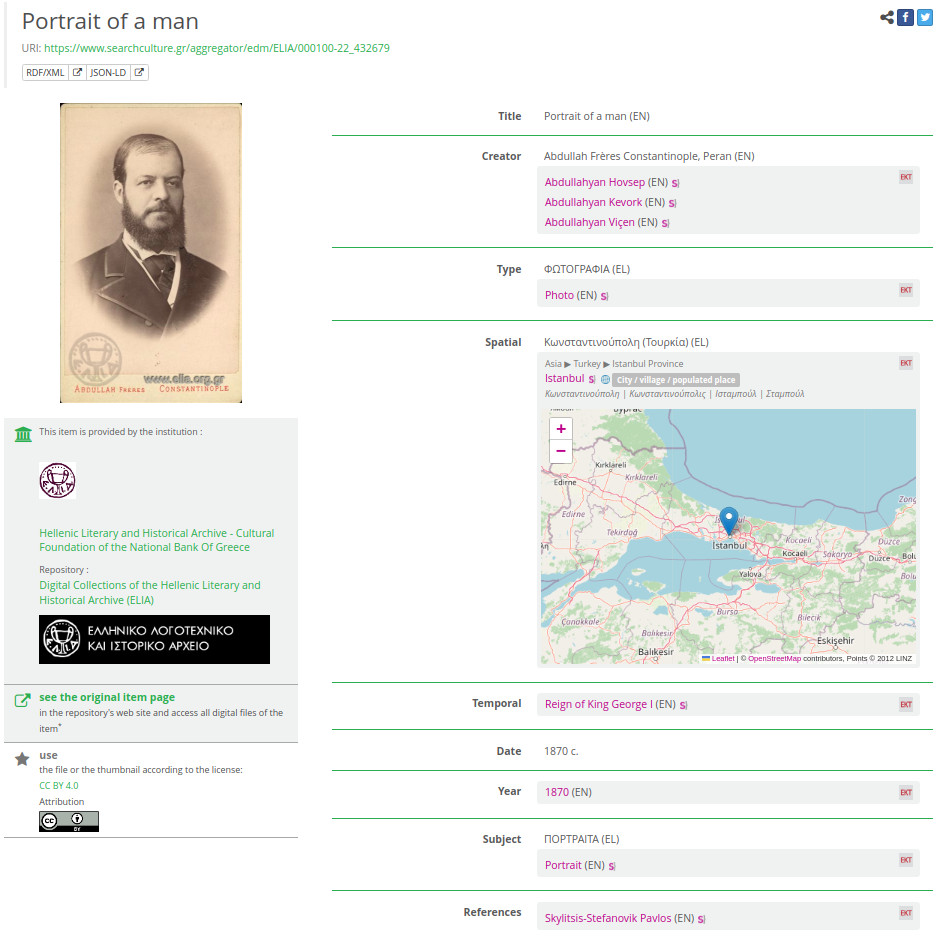
The Item View contains a thumbnail, usually the digital file in
low resolution, and a set of metadata describing it. The result of
EKT’s semantic enrichment (author, item type, geographic coverage,
historical period, date, subject and referenced entity) is shown in
pink letters (links) in a grey background, to indicate its
different from the original institution metadata. The values, which
include reference to vocabularies and thesauri of terms, appear as
links that lead to pages of corresponding results, while the button
" " leads to the corresponding
pages of terms on Semantics.gr.
" leads to the corresponding
pages of terms on Semantics.gr.
On the right above the metadata are sharing options for social media.
On the left, below the preview image is the logo of the institution/provider and the collection, the link to the original item page, and the licence to use the digital file designated by the institution.
The primary purpose of SearchCulture.gr is to make items searchable, acting as a specialised search engine for Greek cultural content coming from different institutions. Users can easily go to the original item on the institution’s repository where the digital file can be viewed in full detail with its native documentation, often including additional information.
Sometimes links in an institution’s repository cease to function for reasons beyond SearchCulture.gr's control, such as in the event of server failure. In this case, if, following a prior agreement with the institution, there is a digital copy that has been stored on SearchCulture.gr, it is made available for downloading so that users can have access to the digital file until the problem in the originating repository is rectified.
For a certain number of institutions, the original digital file is also permanently available for download directly from the item tab in the SearchCulture.gr
All items aggregated in SearchCulture.gr are accompanied by a clear, standard and machine-readable licence. The licences are selected by the content providers and describe the way visitors to the aggregator can use the digital items. The licences are for the digital files. The documentation (metadata) is published under a CC0 (Worldwide Public Assignment) licence, which means that metadata can be freely used without any restrictions.
Visitors can use the preview images and digital files that they will find on the portal, according to the options given by the content provider through the standard non-mechanized licenses and the Creative Commons and RightsStatements.org licensing tools chosen.
EKT supports open licenses, which means licenses that give permission to anyone to use the work at no cost, and generally allow anyone to modify the work with no or minimal restriction (such as acknowledging the original author’s work).
There are several open licenses that follow these principles, among the most commonare Creative Commons licenses for written works, music, visual and other artistic expressions. Open licensing allows that material can be shared and reused under terms that are flexible and legally sound. The licences used in SearchCulture.gr, in accordance to Europeana, are the following:
The work has been identified as being free of known restrictions under copyright law, including all related and neighboring rights. The user can copy, modify, distribute and perform the work, even for commercial purposes, all without asking permission.
The institution/creator who associated a work with this deed has dedicated the work to the public domain by waiving all of his or her rights to the work worldwide under copyright law, including all related and neighboring rights, to the extent allowed by law. The user can copy, modify, distribute and perform the work, even for commercial purposes, all without asking permission.
This license allows users to distribute, remix, adapt, and build upon the material in any medium or format, so long as attribution is given to the creator. The license allows for commercial use.
CC BY includes the following elements:
BY – Credit must be
given to the creator
This license allows users to distribute, remix, adapt, and build upon the material in any medium or format, so long as attribution is given to the creator. The license allows for commercial use. If you remix, adapt, or build upon the material, you must license the modified material under identical terms.
CC BY-SA includes the following elements:
BY – Credit must
be given to the creator
SA – Adaptations must be shared
under the same terms
This license allows users to distribute, remix, adapt, and build upon the material in any medium or format for noncommercial purposes only, and only so long as attribution is given to the creator.
It includes the following elements:
BY – Credit must be
given to the creator
NC – Only noncommercial uses of the
work are permitted
This license allows users to copy and distribute the material in any medium or format in unadapted form only, and only so long as attribution is given to the creator. The license allows for commercial use.
CC BY-ND includes the following elements:
BY – Credit must
be given to the creator
ND – No derivatives or adaptations
of the work are permitted
This license allows users to distribute, remix, adapt, and build upon the material in any medium or format for noncommercial purposes only, and only so long as attribution is given to the creator. If you remix, adapt, or build upon the material, you must license the modified material under identical terms.
CC BY-NC-SA includes the following elements:
BY – Credit
must be given to the creator
NC – Only noncommercial uses
of the work are permitted
SA – Adaptations must be shared
under the same terms
This license allows users to copy and distribute the material in any medium or format in unadapted form only, for noncommercial purposes only, and only so long as attribution is given to the creator.
CC BY-NC-ND includes the following elements:
BY – Credit
must be given to the creator
NC – Only noncommercial uses
of the work are permitted
ND – No derivatives or
adaptations of the work are permitted
The item is subject to Intellectual Property status. The user has the right to use the item only in the ways allowed by the relevant legislation. Any other use requires the permission of the copyright owner.
The item is protected by copyright. The user has the right to use the item only in the ways allowed by the relevant legislation. For any other use, it must obtain permission from the copyright holders unless such use is for educational purposes.
The item is not protected by intellectual property but is subject to restrictions on use due to possible other legal regulations, such as Law 3028/2002 on the protection of Antiquities and Cultural Heritage in general.